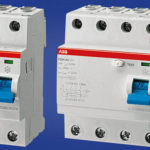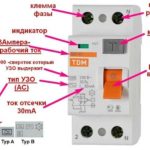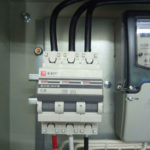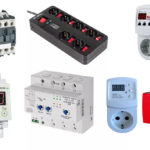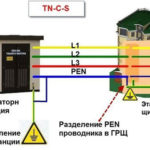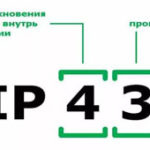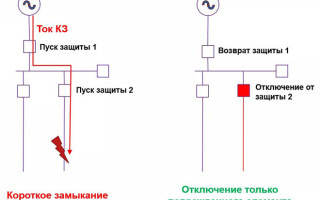One of the key concepts in the field of electrical engineering is selectivity. It is no secret that the safety of the operation of electrical networks is extremely important, and it can be ensured in many ways. Selectivity - This is a special function of relay protection, thanks to which it is possible to avoid damage to devices and increase their service life.
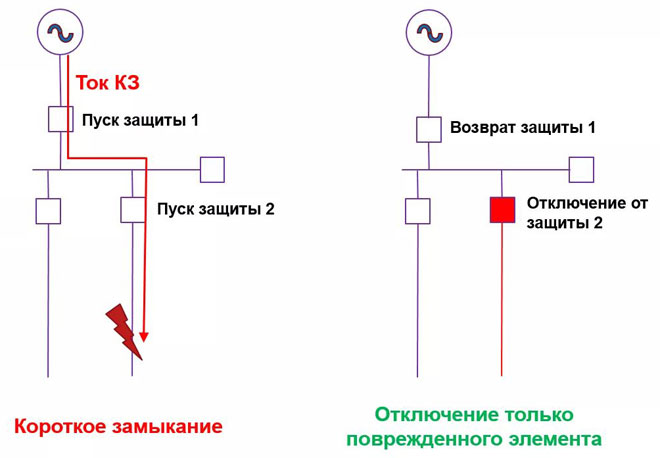
Content
General concept of selectivity
As already mentioned, selectivity is understood as a feature of relay protection. It is determined by the ability to look for a faulty element in the entire electrical network and turn off the emergency section, and not the entire system.
Selective protection can be absolute and relative.
- Absolute protection involves the precise operation of the fuses in the section of the network where a short circuit or breakdown occurred.
- Relative selectivity causes the shutdown of the automata, which are also located near the breakdown site, if the protection in those areas did not work.
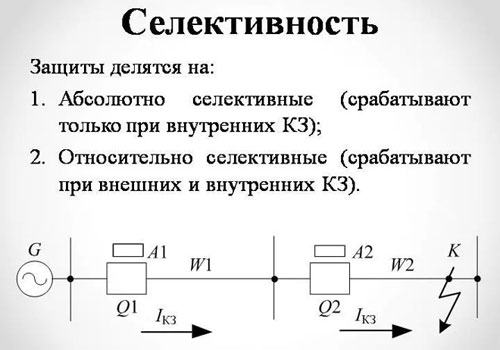
Main Functions
The key tasks of selective protection are to ensure the uninterrupted operation of the electrical system and the inadmissibility of burning mechanisms when threats appear. The only condition for the correct operation of this type of protection is the consistency of the protective units with each other.
As soon as an emergency situation arises, the damaged section is instantly identified and switched off with the help of selective protection. At the same time, serviceable places continue to work, and disabled ones do not interfere with this in any way. Selectivity significantly reduces the load on electrical installations.

The basic principle of arranging this type of protection lies in the equipment of automatic machines with a rated current that is less than that of the device at the input. In total, they can exceed the face value of the group machine, but individually - never. For example, when installing an input device of 50 A, the next device should not have a rating higher than 40 A. The unit that is as close as possible to the place of emergency will always work first.
NOTE! The choice of automatic devices, including those for protection with absolute selectivity, depends on their rating and operation characteristics, which are designated B, C and D. Often, devices that protect the electrical system are various types of automatic devices, fuses, RCD.
Thus, the main functions of selective protection include:
- ensuring the safety of electrical appliances and workers;
- quick identification and shutdown of the zone of the electrical system where the breakdown occurred (at the same time, the working zones do not stop functioning);
- reduction of negative consequences for the working parts of electromechanisms;
- reducing the load on the component mechanisms, preventing breakdowns in the faulty zone;
- Guarantee of uninterrupted working process and constant power supply of high level.
- support for optimal operation of a particular installation.
Types of selective protection
Full and partial
Full protection is intended for serial connection of devices. In the event of an accident, the protective unit that is closest to the place of failure will work as quickly as possible. Partial selective protection is in many ways similar to full, but only functions up to a certain current value.
Time and time current

Time selectivity is when devices connected in series with identical current characteristics have a different operating time delay (with a sequential increase from the problem area to the power source). Temporary protection is used so that the machines can insure each other in the event of a failure. For example, the first one should work after 0.1 seconds, if it is faulty, after 0.5 seconds the second one comes into play, and if necessary, the third one will work after 1 second.
Time-current selectivity is considered as difficult as possible. For it, equipment of 4 groups is used - A, B, C and D. Each of them has a personal reaction to the electric current and shutdown at the right time. The best protection is achieved in group A, which is mainly used for electrical circuits. The most popular type of units is C, but experts do not recommend installing them everywhere and thoughtlessly.
Current selectivity
This variety is similar in the method of work to the time one, however, the difference is that the main criterion is the limiting value of the current mark. The current values are arranged in descending order from the power source to the load objects.

If a short circuit occurs near switch A, the protection of end B should not work, and the switch itself must remove voltage from the device. In order for current selectivity to guarantee total selectivity, a high resistance would be required between both switches. It is obtained with:
- extended power line;
- transformer winding inserts;
- inclusion in the gap of a wire with a smaller cross section.
Energy
This scheme implies the speed of the selectivity of autoswitches. Wherein short circuit currents (KZ) are not able to reach their maximum values.
These “quick-fire” automata work for literally a couple of milliseconds. Due to the high dynamism of loads, it is extremely difficult to coordinate the actual time-current parameters of protection.
The average user does not have the ability to track the characteristics of this type of selectivity. The manufacturer is obliged to provide them in the form of graphs and tables.
Zone selectivity
Such schemes are often used in industrial facilities. This is not only a very complicated, but also an extremely expensive way of protection. To use zone selectivity, you need to purchase special tracking devices.
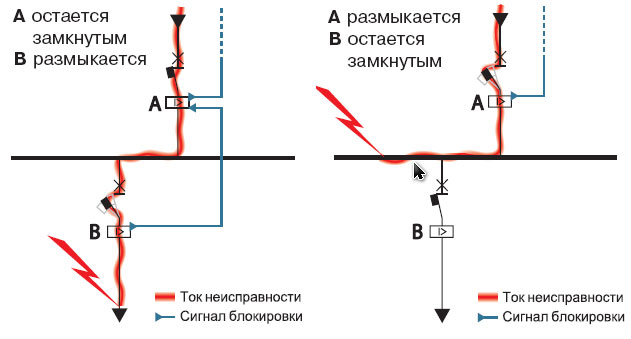
All data obtained during the operation of the devices are concentrated in the control center. It determines which machine must be used to disable it.
These devices use electronic releases. Their scheme of work is as follows: when an emergency occurs, the lower device sends a signal to the one above. If after 1 second the lower device does not work, the second one takes over.
Calculation of the selectivity of automata
Protection devices are in most cases not some tricky devices, but standard and well-known auto switches. To provide them with the correct selectivity, you just need to choose the right parameter settings. The operation of such units is based on the following condition:
Ic.o.last ≥ Kn.o.* I k.prev., where:
- Iс.о.posled - current at which the protection begins to operate;
- I k.prev. — short-circuit current at the end of the protective zone;
- Kn.o. — reliability coefficient, which depends on a number of settings.
It is possible to calculate the selectivity in the time control of devices using the following scheme:
tс.о.last ≥ tк.prev.+ ∆t, where:
- tс.о.last and tк.prev. - time intervals through which cutoffs of automata are triggered in order of proximity to the power source;
- ∆t is the time step of selectivity.
Selectivity Map
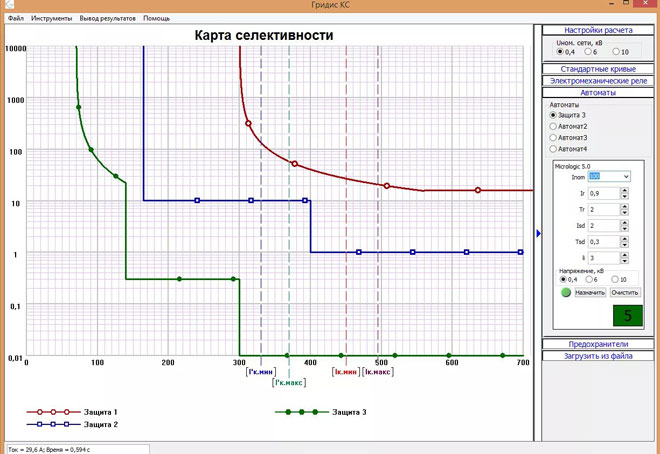
To ensure the highest possible level of circuit breaker protection, a selectivity map or its visual representation is required. The map is a kind of scheme that displays all the complexes of current parameters in the power grid.
To create a correct selectivity map, you need to adhere to the following provisions:
- electrical installations must be connected to a single power source;
- it is necessary to choose the scale correctly so that all calculated points fit on it;
- in addition to the qualities of automata, it is necessary to designate the maximum and minimum short circuit values at the points of the system.
The parameters of the units are plotted on the map in turn, which is determined by the order of their connection. To correctly build diagrams, you need to use axes with key indicators. A properly mapped is the key to an easy comparison of protection device parameters and overall selectivity.
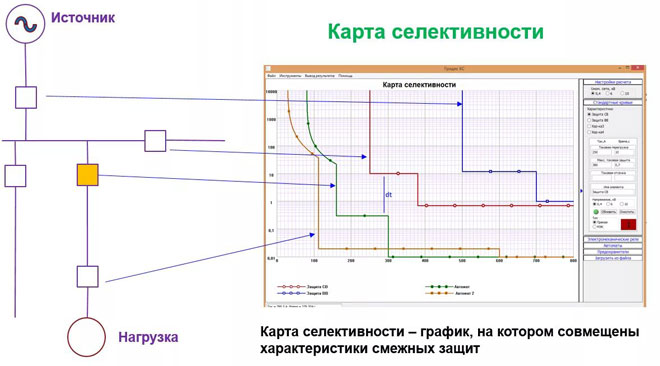
NOTE! To make a map faster, you should use a special program. It can be easily found on the World Wide Web.
Conclusion
Often in household electrical networks current or time selectivity is used. The best way to do this is to RCD installationwhen there is one common switch, and several more are located on the loop. Selective protection contributes to the correct and uninterrupted operation of the equipment.
Similar articles:
